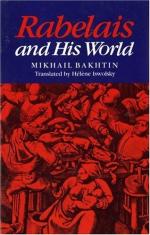
|
| Name: _________________________ | Period: ___________________ |
This test consists of 15 multiple choice questions and 5 short answer questions.
Multiple Choice Questions
1. In which element of Shakespeare's dramas does Bakhtin see the overall theme of Rabelais' carnivalesque repeated?
(a) In the logic of crownings and uncrownings.
(b) In the strengths of characters such as Hamlet and Othello.
(c) In the farcical secondary characters.
(d) In the tragic elements of Shakespeare's romances.
2. Which aspect of Renaissance culture does Bakhtin stress is still apparent in Western society today?
(a) Public thrashings.
(b) Clowns and fools.
(c) Street cries.
(d) Carnival.
3. Bakhtin asserts that Rabelais' grotesque conception of the body reflected:
(a) The Calvinist idea of predestination and grace.
(b) The Renaissance re-envisioning of the cosmos.
(c) The Classical philosophy of Epicureanism.
(d) The Medieval doctrine of natural hierarchy.
4. Bakhtin asserts that man introduces the world to himself primarily through which act?
(a) Eating.
(b) Observing nature.
(c) Conversation.
(d) Sexual intercourse.
5. What word characterizes Medieval thinking, according to Bakhtin?
(a) Hierarchical.
(b) Self-contradictory.
(c) Scientific.
(d) Pessimistic.
6. Bakhtin generally finds Goethe's sense of Carnival's _____________ to agree with his own views.
(a) Universalism.
(b) Pessimism.
(c) Religiousness.
(d) Poetic expression.
7. How does Bakhtin define the combination of human and animal organs in Rabelais' novel?
(a) "Scientific."
(b) "Horrifying."
(c) "Grotesque."
(d) "Otherworldly."
8. Bakhtin asserts that "The Play in the Bower" influenced Rabelais' work specifically in its:
(a) Adherence to the rules of proper religious worship.
(b) Demonstration of rigid and correctly class-conscious behavior.
(c) Themes of unofficial laughter and banquet imagery.
(d) Themes of human sadness, pessimism, and regret.
9. At the beginning of Chapter 6, Bakhtin argues that Rabelais' entire novel exhibits a clear, general __________ thematic trend.
(a) Upward.
(b) Conservative.
(c) Downward.
(d) Liberal.
10. According to Bakhtin, Carnival was the true symbol and incarnation of:
(a) The folk festival.
(b) The natural world.
(c) The sanctity of the Church.
(d) The power of the monarchy.
11. How does Bakhtin define "folly" as it relates to festivity?
(a) Pessimistic.
(b) Artistic.
(c) Ambivalent.
(d) Inaccessible.
12. How does Bakhtin say Ivan the Terrible of Russia was similar to Rabelais?
(a) He also was a prolific and controversial writer.
(b) He too challenged old political and social structures.
(c) They both travelled anonymously to Carnival festivities.
(d) They both fought bloody battles against the reigning monarch.
13. What body part is most often used in grotesque caricatures of sexual potency?
(a) The torso.
(b) The hands.
(c) The feet.
(d) The nose.
14. How does Bakhtin define the episode involving Villon and Tappecoue?
(a) As a tragic farce.
(b) As an epic drama.
(c) As a historical re-enactment.
(d) As a comedic interlude.
15. The defense of the abbey by Friar John contains:
(a) A caricature of the Pope.
(b) A grotesque combination of sexual intercourse and war.
(c) A travestied allusion to Communion.
(d) A debasing description of the French people.
Short Answer Questions
1. What do wine and oil symbolize in Rabelais' novel?
2. What particular tradition did Peter the Great bring to Russia from Western Europe?
3. Which grotesque elements does Bakhtin note were included in the procession of the feast of Corpus Christi?
4. What is a Renaissance "diablerie"?
5. In the Fourth Book, why does Villon set a trap for Tappecoue (or "Ticklepecker")?
|
This section contains 609 words (approx. 3 pages at 300 words per page) |

|




